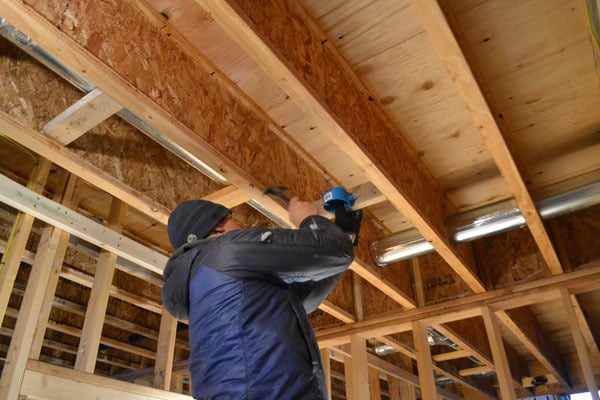There's a heated battle going on up at the Momplex.
Or maybe I should say a battle over what type of heat system we should put upstairs in the Momplex.

Downstairs, in the bonus areas and the garages, we've got water tubing poured inside the concrete slab. All we have to do to heat the downstairs is run hot water from a boiler through those pipes, and it will warm the floor, radiating heat throughout the lower floor.
But upstairs is where we are having the heated battle.
Originally, we had decided on baseboard heat because it's simple and cheaper.

image from Home Depot
I know, I know, not the prettiest option, but we liked the idea of baseboard because they would be quick and easy to install, and the heat system would react faster to temperature changes. We have radiant heat in our garage, and it seems to be lethargic when adjusting to a heat change. Coupling the downstairs radiant heat slab with the baseboards upstairs could give us the best of both, right?
Well, no. What happens when you run baseboard heat is you have to run your boiler at a higher temperature. This makes the system less efficient in the long run - meaning it will cost Mom more money to heat the Momplex than full radiant heat would.
So we started thinking about installing radiant heat in the upstairs as well. Then we would be able to run the entire boiler system at a lower temperature.
I know, I know, those of you who build professionally, you can say it .... you really want to plan for and install radiant heat BEFORE any other utilities, or at least plan for it to be placed over your subfloor. It really is not ideal to decide to change your heat system this late in the game.
But here's reality. Changing a heat system after finishing the Momplex, say a few years down the road when heating fuel is $6 or $8 a gallon, well, that's more than just not ideal. It a full blown remodeling job involving ripping down drywall and running tubing. The old saying "it's better late than never" is definitely true here.
So, we are doing tons of research, and it seems the options for radiant heat have really expanded in the last few years. And our options for installing radiant heat upstairs have grown considerably.

Image from Comftemp
We could install the tubing under the subfloor between the rafters, and use aluminum heat transfer plates to transfer the heat from the water lines to the floor.
Would the heat rise? What plates would work best?

image from Healthy Heating
Or we could place the tubing on top of the subfloor in the aluminum transfer plates, and fill in the gaps with plywood. The benefit here is the heat is directly under your flooring - not separated by subflooring - so the heat transfers more effectively to your warm cozy toes.
Is this better than below the floor?

Image from Glockzin Heating
On some installations, a thin layer of concrete is actually poured on the upstairs floors with the tubing, to create an effective means of transferring the heat out of the hot water in the tubes into the floor.

And then there's the FlexPlate - which is graphite instead of aluminum, which is supposed to aid heat transfer even more. Does it work? Is it worth the extra $$$?

Image from Ultra-Fin
And then there's the Ultra-Fin, which works kinda like a hybrid between the baseboard heater and the radiant. You snap the ultra-fins on your tubing, suspended below the floor, and it works like a baseboard, drawing the heat out of the pipe and heating the air space between the joists. You then insulate the bottom of the joists and count on heat rising to warm your floors. We love the Ultra-Fins because you'll need about half the tubing, which is half the work installing, and it will recover quicker (in theory) when we have dramatic temperature changes, but we can still run the boiler at a lower temperature.
Question is, will it work as advertised?
And that's the biggest question of all - will it work? What system is better? How will you know?
We've been reading tons of reviews and doing research online, but at the end of the day, I just want to hear from real people what works in their homes for radiant heat.
Lucky for me, I know you! Do you have a radiant heat system? What kind is it? Do you love it or hate it? Would you have done something different? Do you have the Ultra-Fin system? Does it work?
Thank you so much for taking the time to comment and help us with this really big, and hopefully hot, decision!

Comments
AdrienneB
Thu, 02/07/2013 - 11:17
Radiant plus radiators
jinsin1
Thu, 02/07/2013 - 11:24
Heat
Tsu Dho Nimh
Thu, 02/07/2013 - 11:27
More
jlbarahona
Thu, 02/07/2013 - 12:58
radiant heat
jvos
Thu, 02/07/2013 - 14:04
radiant heat in super insulated homes
RobRoy
Thu, 02/07/2013 - 14:25
Heat
Tsu Dho Nimh
Fri, 02/08/2013 - 08:37
Inapplicable advice
annalea
Thu, 02/07/2013 - 17:52
Two options I've used.
opalm
Thu, 02/07/2013 - 17:56
radiant heat
Jasi
Thu, 02/07/2013 - 18:00
heat
rhulshizer
Thu, 02/07/2013 - 18:38
radiant heat
Gizmoredtoot
Thu, 02/07/2013 - 19:45
Hydronic choices
sblanc
Fri, 02/08/2013 - 07:58
I installed an under subfloor
pincky
Fri, 02/08/2013 - 08:15
Hi Ana, Love your blog! My
Ana White
Fri, 02/08/2013 - 11:59
A huge thank you to everyone
loudsilence99
Fri, 02/08/2013 - 14:11
Didn't you have to use thicker beams anyway...?
erinn.richardson
Sun, 02/10/2013 - 12:27
Love our simple system! Our
Jenlow321
Fri, 03/20/2015 - 13:35
how do I view the previous
how do I view the previous comments?